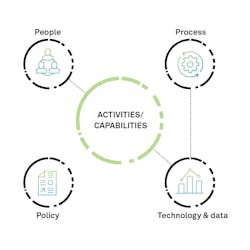The oil and gas industry seems to be stuck in a period of perpetual volatility. Such constant uncertainty can take its toll—even forcing some oil and gas producers into bankruptcy. Producers that can channel today’s challenges into opportunities for growth are much better positioned to not just survive, but become industry leaders. Securing such a valued position requires resources that allow an entire company to be more efficient and enable the agility to quickly respond as the market shifts.
One key way oil and gas producers are laying the foundation for success is by working together, producing a capital facility and information hand over specification [CFIHOS] that fosters the exchange of engineering digital twin data and content providing interoperability for autonomous operations and maintenance. Hexagon products are designed to produce and consume CFIHOS compliant information data and content.
Embracing maintenance as-a-service promotes autonomous operations and maintenance to ensure the integrity of mission-critical assets. Industry 5.0 has shifted the focus from advanced technologies to how people use these technologies in the safe and profitable operation of oil and gas facilities and pipelines. Organizations can expect a not-so-distant future where traditional Enterprise Asset Management (EAM) evolves to an Asset Performance Management (APM) platform that consistently innovates through:
- Using operational digital twin for greater visibility to track, manage, and maintain key systems and equipment
- Automating data capture and transformation between EPCs, contractors, and operating units
- Integration capabilities that drives interoperability between maintenance, safety, operations, and regulatory compliance
Read on to discover six ways that an asset performance management platform can help oil and gas producers achieve operational efficiency, streamline operations, reduce risks, and increase profitability.
1. Boost operational efficiency
A cloud native APM platform can help maximize efficiency at every step of the fossil fuel production chain. The right solution supports and promotes proactive strategies, such as predictive or condition-based monitoring. This enables producers to boost the reliability of assets and equipment—resulting in decreased equipment and production downtime in upstream operations. An APM solution that provides real-time insights at every step ensures that essential equipment and systems are maintained and operated on an optimal schedule, based on usage and conditions.
2. Leverage mission-critical data to drive efficiency
When an APM platform is utilized as part of an integrated enterprise software solution, it can be a powerful tool to leverage mission-critical data and drive efficiencies across the company. For instance, when maintenance and operations teams can receive real-time updates on equipment status, they have access to critical data that enables them to prevent breakdowns before they occur and set informed priorities. Or when frontline maintenance teams can access manuals, schematics, and equipment status reports on their mobile devices, they have immediate access to information that can help them complete repairs and overhauls quickly and safely. And providing senior management with aggregated reports that integrate with key internal and external data allows them to build a complete picture of operational performance.
3. Reengineer business processes
Effective business processes are about integrating technology and data with people, processes, and policy. When APM operates as an essential component of an integrated, cloud native digital backbone, oil and gas producers can gain significant benefits, such as:
- Establishing, maintaining, and depending on a robust data management system across the entire enterprise
- Using best-in-class cybersecurity and frequent, routine updates—allowing in-house IT to focus on enterprise-specific needs
- Blueprinting key processes to drive efficiency and augmenting them with digital enablers
- Supporting governance and management systems to help ensure alignment and optimize the flow of data and information—both within and between departments and business units
- Creating a collaborative workplace culture
4. Empower users
Innovative oil and gas producers understand that their success depends on satisfying customers and empowering and motivating employees. The right APM platform delivers this via a hyper-personal experience that greatly enhances user productivity. Leveraging modern technologies—such as deep industry-specific functionality, machine learning, business analytics, and artificial intelligence (AI)—makes the user experience even more efficient and intuitive. This can be a critical factor as millennials advance in the workforce and become the most influential customer segment. Millennials expect the benefits of modern technology and digital transformation at their fingertips—anywhere, at any time—via mobile and similar technologies. Their satisfaction might ultimately determine a producer’s ability to deliver on its business goals.
5. Improve regulatory compliance and reduce risk
Shareholder value and competition are key drivers for any business, but oil and gas is an industry where compliance, risk mitigation, and safety must come first. When every installation is highly sophisticated and processes are complex, mitigating risk means not just monitoring equipment and components, but also developing a workplace culture that keeps employees safe and productive. The ability to mitigate risks and meet regulatory requirements should begin with a 360-degree view of the entire enterprise. This can be accomplished with a cloud native platform that combines predictive maintenance, business analytics, machine learning, and AI to spot problems before they occur, while also optimizing oversight and reporting. Proper regulatory compliance depends on robust integration tools that begin with enterprise asset management, but extend into all aspects of the operation.
6. Be ready for what comes next
Leveraging timely, targeted data is the key to navigating a rapidly-evolving, sometimes treacherous business environment. The unprecedented changes that have hit oil and gas in the last two years showed the importance of preparedness at all levels of operation—from the performance of specific assets to the big-picture resilience of the entire enterprise. This brings a new level of urgency to the IT trends identified in the IDC FutureScape Worldwide IT Industry 2020 Predictions report (doc # US45599219, October 2019, p. 2.), such as:
- Digital transformation and innovation will account for over 50% of IT spending by 2024
- 70% of enterprises will integrate cloud native management by 2022
- More than 50% of new enterprise IT infrastructures will be deployed at the edge—rather than in corporate data centers— by 2023
- Nearly two-thirds of enterprises will produce their own software and deploy it daily by 2025
- At least 90% of new enterprise apps will embed AI by 2025 departments and business units
Any or all of these changes could bring a producer’s business the efficiencies and data-driven insights to thrive in moments of unique challenges. Cloud native enterprise
software services must have the versatility to support this journey.
Maintain a competitive edge
A growing number of oil and gas producers are actively integrating digital technologies across the enterprise for greater efficiency and growth. To continue delivering value, meeting shareholder expectations, and maintaining a competitive edge, oil and gas companies need to recognize the value of integrating platforms, software, and
processes—especially during a constantly unpredictable and turbulent business cycle.

